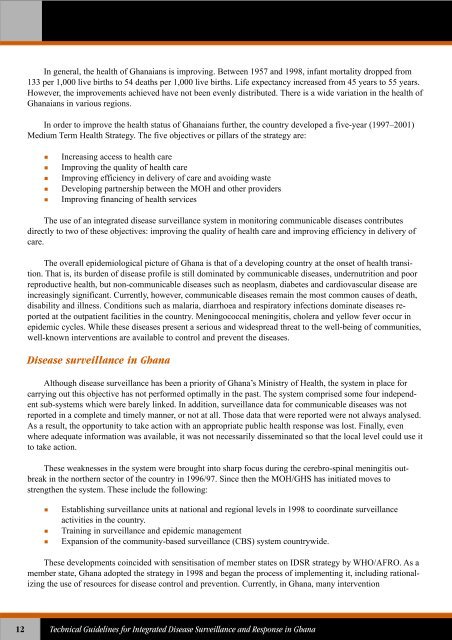Technical Guidelines for Integrated Disease Surveillance ... - PHRplus
Technical Guidelines for Integrated Disease Surveillance ... - PHRplus
Technical Guidelines for Integrated Disease Surveillance ... - PHRplus
You also want an ePaper? Increase the reach of your titles
YUMPU automatically turns print PDFs into web optimized ePapers that Google loves.
In general, the health of Ghanaians is improving. Between 1957 and 1998, infant mortality dropped from133 per 1,000 live births to 54 deaths per 1,000 live births. Life expectancy increased from 45 years to 55 years.However, the improvements achieved have not been evenly distributed. There is a wide variation in the health ofGhanaians in various regions.In order to improve the health status of Ghanaians further, the country developed a five-year (1997–2001)Medium Term Health Strategy. The five objectives or pillars of the strategy are:Increasing access to health careImproving the quality of health careImproving efficiency in delivery of care and avoiding wasteDeveloping partnership between the MOH and other providersImproving financing of health servicesThe use of an integrated disease surveillance system in monitoring communicable diseases contributesdirectly to two of these objectives: improving the quality of health care and improving efficiency in delivery ofcare.The overall epidemiological picture of Ghana is that of a developing country at the onset of health transition.That is, its burden of disease profile is still dominated by communicable diseases, undernutrition and poorreproductive health, but non-communicable diseases such as neoplasm, diabetes and cardiovascular disease areincreasingly significant. Currently, however, communicable diseases remain the most common causes of death,disability and illness. Conditions such as malaria, diarrhoea and respiratory infections dominate diseases reportedat the outpatient facilities in the country. Meningococcal meningitis, cholera and yellow fever occur inepidemic cycles. While these diseases present a serious and widespread threat to the well-being of communities,well-known interventions are available to control and prevent the diseases.<strong>Disease</strong> surveillance in GhanaAlthough disease surveillance has been a priority of Ghana’s Ministry of Health, the system in place <strong>for</strong>carrying out this objective has not per<strong>for</strong>med optimally in the past. The system comprised some four independentsub-systems which were barely linked. In addition, surveillance data <strong>for</strong> communicable diseases was notreported in a complete and timely manner, or not at all. Those data that were reported were not always analysed.As a result, the opportunity to take action with an appropriate public health response was lost. Finally, evenwhere adequate in<strong>for</strong>mation was available, it was not necessarily disseminated so that the local level could use itto take action.These weaknesses in the system were brought into sharp focus during the cerebro-spinal meningitis outbreakin the northern sector of the country in 1996/97. Since then the MOH/GHS has initiated moves tostrengthen the system. These include the following:Establishing surveillance units at national and regional levels in 1998 to coordinate surveillanceactivities in the country.Training in surveillance and epidemic managementExpansion of the community-based surveillance (CBS) system countrywide.These developments coincided with sensitisation of member states on IDSR strategy by WHO/AFRO. As amember state, Ghana adopted the strategy in 1998 and began the process of implementing it, including rationalizingthe use of resources <strong>for</strong> disease control and prevention. Currently, in Ghana, many intervention12<strong>Technical</strong> <strong>Guidelines</strong> <strong>for</strong> <strong>Integrated</strong> <strong>Disease</strong> <strong>Surveillance</strong> and Response in Ghana















